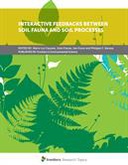Explore

Interactive Feedbacks between Soil Fauna and Soil Processes
0 Ungluers have
Faved this Work
Login to Fave
Soil fauna plays a significant role at all trophic levels of the soil food web and regulates processes that are crucial for soil functioning, such as nutrient cycling, immobilization and/or degradation of toxic compounds, formation of soil structure, greenhouse gas emissions and C turnover. Although soil fauna is not thought to contribute significantly to soil respiration during litter or soil organic matter (SOM) decomposition, the diversity of soil fauna has been found to strongly influence SOM distribution and dynamics. Yet, the functional contribution of soil fauna to many soil processes is not well understood due to methodological limitations and the high complexity of interactions at various spatiotemporal scales. In general, soil fauna has received far less scientific attention than bacteria and fungi (and lately archaea) in soil studies and has been regularly ignored in global biogeochemical models, with maybe exceptions for some earthworms. However, recent studies are raising the awareness of the influence of soil fauna on ecosystems dynamics. For instance, earthworms have been found to be major players in N2O emissions from soils. They exert a strong influence on C stabilization, and they promote the degradation of polycyclic aromatic hydrocarbons (PAHs). Less studied, ants and termites have been found to increase crop productivity in drylands, and different lifeforms of Collembola have been shown to impact microorganisms in various ways over time, thereby potentially affecting C and N cycles within farming systems. The influence of soil fauna indeed manifests over a broad ranges of spatiotemporal scales. For example, some effect such as aggregate formation may cumulate over time and finally contribute to the formation of whole soil profiles, which serve as a framework for other soil processes such as water movement, decomposition, etc. Meanwhile, soil biodiversity is impacted by an increasing human pressure through deforestation, agriculture intensification, habitat fragmentation or climate change (increasing temperatures, extreme weather events), which leads to soil biodiversity loss, in particular of soil fauna, with associated consequences on soil functioning and resilience.
This book is included in DOAB.
Why read this book? Have your say.
You must be logged in to comment.
Rights Information
Are you the author or publisher of this work? If so, you can claim it as yours by registering as an Unglue.it rights holder.Downloads
This work has been downloaded 175 times via unglue.it ebook links.
- 62 - mobi (CC BY) at Unglue.it.
- 50 - epub (CC BY) at Unglue.it.
- 63 - pdf (CC BY) at Unglue.it.
Keywords
- biogeochemical cycles
- C sequestration
- Earthworms
- Environmental science, engineering & technology
- greenhouse gas
- macroarthropods
- Mathematics & science
- microarthropods
- nematodes
- protists
- resilience
- Science: general issues
- soil alterations
- soil functions
- soil stability
- soil structure
- Technology, engineering, agriculture
- thema EDItEUR::P Mathematics and Science::PD Science: general issues
Links
DOI: 10.3389/978-2-88963-548-1Editions

